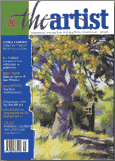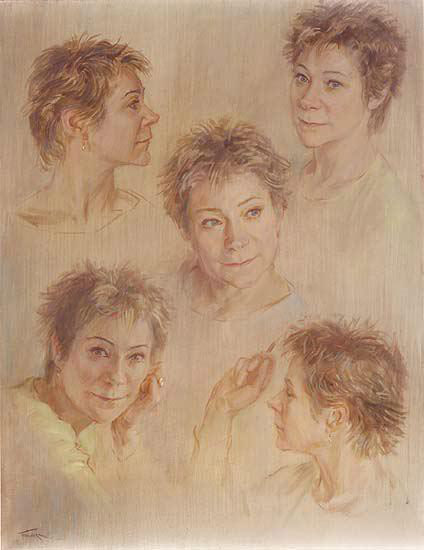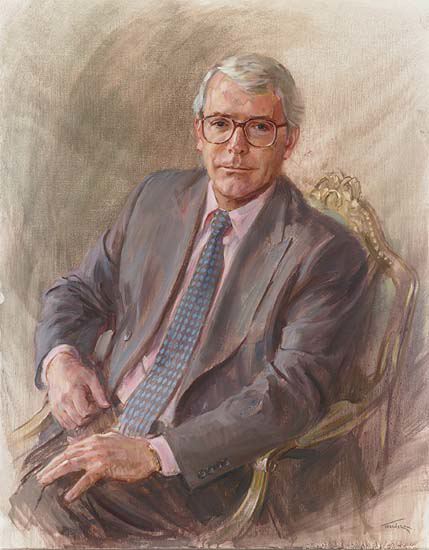June Mendoza - Body Language. Article by Oliver Lange, published in "The Artist" November 2000

Body Language
June Mendoza likes to paint someone seen in a pub whose face interests her, as well as her commissions for portraits in oils of the royal family and famous names in politics and entertainment - but the rules are different!
With commissions that have included members of the royal family, prime ministers, well-known businessmen and famous sportsmen and musicians, June Mendoza has painted eminent figures from many different walks of national life and she is widely regarded as one of the most notable and successful portrait painters of the present day. Her now firmly established reputation and acclaim can be attributed to a number of factors, not least her skill in revealing something of the character and personality of each of her subjects, as well as their likeness. But, equally, her success owes much to an interest in painting that dates back to her childhood and an ability to paint which she describes as "a gift".
As a young girl June used to go on tour with her mother, who was a musician, and she worked in small mime parts and crowd scenes with the De Basil Russian Ballet Company, where she would often make sketches during classes, rehearsals and performances. "By the age of 12 art was an obvious and unquestionable direction for me", she says, "and at 14, I was attending life classes". Whilst still in her teens she began a career as a designer and illustrator, occasionally painting portraits, and then, after a period working as a professional actress, she decided to concentrate full-time on painting and portraiture.
 An
interest in people
An
interest in people
Immediately striking about her work is the way she handles paint - her wonderfully sensitive touch - and her versatility. Her paintings perfectly demonstrate that the professional portraitist must be a competent all-rounder when it comes to subject matter, for a painting could, as she explains, "include architecture, landscape, musical instruments, the dog, or anything at all. You might be painting a huge pictorial background". Another essential quality, she adds, is an interest in people, while it is the influence of the perception, selectivity and sensitivity of the artist that will distinguish a painting from a photograph. "A painting is such a personal thing", she says, "because it is created by hand according to the artist's insight, abilities, fortes and frailties. Like handwriting, painting is a very individual means of expression, which is why, even when they are painting the same subject, we see different results from different artists".
The majority of June's portraits are commissions, with about a third of her work based on subjects that she generates herself. She regards this aspect of her work as essential, for it helps to keep all her painting lively and developing. "My own subjects might be people I notice in the street", she says, "or perhaps at a function, in a pub, or wherever. I see someone, I don't know who they are, but they have a face that interests me and one that I want to paint. A lot of exciting things have happened in this way".
Usually there is not the same freedom with a commission. So can it influence or perhaps even inhibit the artist? It can do both, June explains. "If you are a professional you learn to supply what is required within the confines of the contract. The painting might have to be a limited size, for example, to suit a certain location. You start from that and make your picture accordingly. It can be restricting in some ways, but it can also be quite exciting, because the client sometimes suggests something that you had not thought of doing. On other occasions you as the artist must decide whether a suggestion is valid or not. For instance, the choice of a particular coloured dress may make too much of a statement and could prove difficult to work with in relation to flesh tones and other aspects".
Pose and composition
Important points to consider right at the beginning of a painting are the pose and composition. The pose plays a vital part in saying something about the sitter and it is a significant factor within the composition. "My approach", comments June, "is to watch the sitter and find out what they do with their body language. Every person is different in how they move their hands or hold their head, shoulders and so on. Seeing the person in their home and looking through their wardrobe can also tell me quite a lot about them. Consequently, at the first sitting much of the work involves observation and fast decisions. Various factors link the technical and portrait aspects of the painting, and each of these has to be carefully considered and assessed in relation to the others and to the whole. Such factors include composition, colour, form, dynamics and what I want to say about the sitter - whether the person is dignified, forceful, colourful, or whatever".
The background is another aspect of the painting that can be significant both in terms of the composition and in stating something about the sitter. Sheridan Morley, for example, is shown in his study surrounded by books, tapes and papers. "Some of my portraits have backgrounds some do not", says June. "With commissions, sometimes a particular background is requested and therefore I might be painting something that is really interesting and makes a very complicated design. On the other hand I recently started a painting in which the background included only a music stand, because I felt that this was all that was necessary".
A sense of energy
June prefers to paint in natural light, very occasionally using artificial light on the sitter or background to dramatise or highlight areas. But her canvas is always placed in daylight so that she can see exactly the colours she is using. It is, of course, through the observation of light and dark that artists understand form and are thereby able to portray it, although also necessary to the portraitist is a knowledge of anatomy. This is a subject that June has studied, and she is also fortunate in that she has a natural gift for seeing how things work anatomically. "It's like a lot of things that you study", she says. "To learn about anatomy means that you have an insight into it. Thus you can leave out what you want, because you understand what you are leaving out. Knowing what happens beneath the surface is important to me in the way that I work. I like a picture to have a feeling of energy - not just an alert face but some alertness in the body language as well".
June works in oil paints on canvas. "Oil paint has got lots of guts", she enthuses, "and it is long lasting, there are rich colours, you can work over it, and it is in the grand tradition. Oils also help me achieve an alive feel with the paint. I like to aim for a sense of dynamism and freedom: you can see where I have put the paint on." Her ready-prepared canvases are treated with a turpsy wash of colour to obliterate the white. "If you work on white you will find it tremendously difficult to assess your tonal range", she advises.
Her palette is quite extensive. "I have about 17 colours that I put out and although I might never use some of them, I like them to be there". On the subject of painting flesh tones her advice is to look carefully at the sitter and the colour you see in front of you in that particular area. "The whole painting has got to be worked up in contrasts of that colour against something else. I tell people to look at the palm of their hand if they are doubtful about the colours that can appear in flesh tones, such as oranges, greens, yellows, mauves and different pinks. It is a question of looking - that is what painting is all about! Quite a wide range of colours can contribute towards mixing flesh tones, including flesh colour, orange, Naples yellow, lemon yellow, cadmium green, olive green and white. I may use flesh colour as a base or starting point, but other colours are added to this to achieve the precise colour I require".
 Developing
the painting
Developing
the painting
Typically, June has six or seven two hour sessions with the sitter and in addition to this she spends whatever time is necessary in the studio painting the background, clothing and other details. When painting ties and pearls, for example, her model is a special bear that sits on a high stool in her studio! She doesn't begin with preliminary drawings but goes straight in with oils, plotting proportions and key points within the composition in terms of 'heads'. Something may be three 'heads' across, for example, or five 'heads' deep. These initial concerns, such as the negative spaces between the figure and the edge of the canvas, the general blocks of tone and colour and the dynamics of the design, "can be thought of as abstract decisions", she says, "but portrait considerations must be developed into these simultaneously".
The process of developing the painting is a complex one which, as June puts it, "involves gut feeling, experience and the particular demands of the subject". The fact is that each decision will influence some other aspect of the painting and so it is always necessary to keep in mind the overall intentions and concept. She doesn't paint to a formula but may start, for instance, by seeing where the hands come and if the hands are lighter than the jacket, where the general areas of light come and how these help or hamper the design, how the interest is being held within the picture, and so on.
The initial shapes and blocks of colour are left "a little bit loose for adjustment", and then gradually resolved. "Each stage is finished to a certain point", explains June. "My aim is not to overwork areas, because the consequence of this is that the entire painting has to be developed unnecessarily." Her advice is to keep your painting under control so that it can be left and perhaps finished earlier than you thought, because you haven't overworked it. In the main the whole painting is developed at the same pace, although she may spend more time on the head and hands. "But it's a funny thing about painting", she says, "that it tends to dictate itself. Something will demand attention and you have got to solve that part before you can continue with the rest. Whether it is putting in the darker tones, or a colour, or some lines, that particular thing insists on being dealt with before you can move on to another section".
And how do you bring out the character of the sitter?
"That is impossible to say! It can be a little flick of the brush
here and a little flick there as you work on someone's face and notice
their expressions. But, to make the portrait valid, it is also a matter
of getting the shoulders, the neck, the hands and the body language doing
what that person does".
![]()
